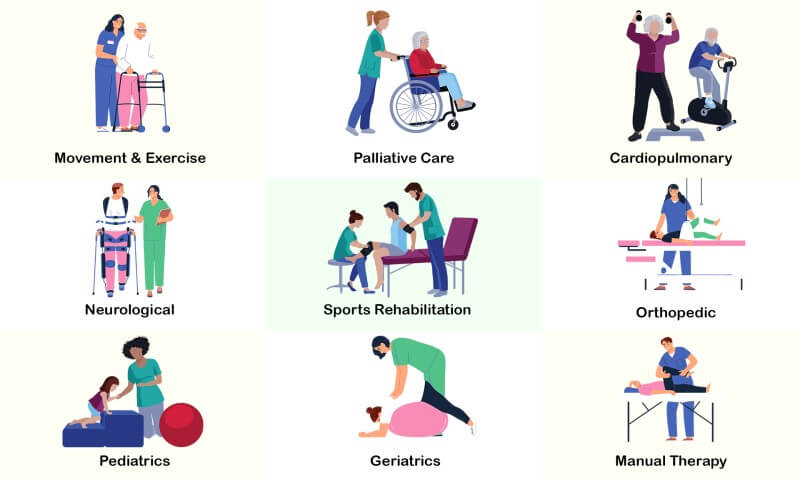Professional Physical Rehabilitation Techniques for Improved Toughness and Health
The domain of professional physical rehabilitation encompasses a selection of techniques designed to enhance both stamina and total well-being. Central to this method is the understanding of customized treatment plans that integrate resistance training, hand-operated treatment, and functional exercises, each serving unique duties in recovery. Furthermore, integrating mindfulness right into these approaches not only helps with emotional durability however additionally boosts patient engagement in their recovery journey. As we explore the implications of these methods, the concern occurs: exactly how can these professional methods be efficiently tailored to satisfy the distinct needs of diverse client populations?
Recognizing Physical Rehabilitation Principles
Physiotherapy concepts are grounded in a holistic understanding of the body and its action to injury and rehab. These principles stress the interconnectedness of physical, emotional, and social factors that affect an individual's health. A basic element of physical rehabilitation includes evaluating the patient's general condition, recognizing disabilities, and developing customized treatment strategies that facilitate recuperation and improve feature.
At the core of physiotherapy is the idea in patient-centered care, where practitioners proactively involve individuals in their rehabilitation procedure. This joint technique fosters motivation and urges adherence to treatment methods. Physio therapists use evidence-based methods to direct their treatments, making sure that techniques and techniques are sustained by present research study.
An additional key concept is the value of activity and feature in rehab. Physiotherapists focus on bring back wheelchair, toughness, and coordination, recognizing that optimum physical function is crucial for total health. Additionally, education and learning plays a vital role in physiotherapy, as experts overview patients in understanding their conditions and embracing healthier way of life selections.
Trick Strategies for Toughness Structure
Stamina building is a vital element of rehabilitation, focused on boosting muscle mass function and total physical efficiency. Physiotherapists employ numerous methods to facilitate this procedure, tailoring programs to meet specific client needs.
One key strategy is resistance training, which includes workouts using weights, resistance bands, or body weight to enhance muscle toughness. This technique effectively targets details muscle mass teams, advertising hypertrophy and endurance. Another crucial method is useful training, which concentrates on exercises that simulate daily tasks, enhancing the capacity to carry out regular tasks with higher ease and toughness.
Progressive overload is likewise crucial in toughness building. This concept entails slowly increasing the intensity of workouts, whether through included weight, increased repeatings, or transformed tempo, making sure consistent adaptation and growth of muscle mass fibers. Furthermore, integrating plyometric exercises can enhance power and explosiveness, which is specifically helpful for athletes and active people.
Last but not least, isometric exercises, where muscle mass agreement without transforming length, can enhance security and toughness in specific joints. By integrating these methods right into individualized rehabilitation programs, physiotherapists can properly sustain patients in accomplishing their strength-building objectives, inevitably bring about improved functional results and improved high quality of life.
Advantages of Guidebook Treatment
Incorporating a variety of therapeutic methods improves the general efficiency of rehab programs, and handbook treatment sticks out as a beneficial strategy. This hands-on treatment contributes in relieving discomfort, boosting flexibility, and promoting the recovery procedure.
Hand-operated treatment includes different techniques, including soft tissue mobilization, joint manipulation, and myofascial release (physio north lakes). These approaches intend to minimize muscle mass tension, enhance circulation, and recover useful motion. By dealing with soft tissue constraints and joint disorders, hands-on therapy can significantly add read more to discomfort relief and improved array of movement
Furthermore, the therapeutic touch associated with hands-on therapy cultivates a strong patient-provider relationship, advertising depend on and comfort. This psychological connection can enhance person adherence to rehab protocols and total contentment with their care.
Research has actually demonstrated that guidebook therapy can be particularly reliable for conditions such as reduced back discomfort, neck pain, and stress headaches. physio north lakes. As a corresponding treatment, it can be incorporated with various other modalities, such as workout or modalities, to maximize outcomes. Inevitably, the benefits of hand-operated therapy emphasize its vital function in extensive physical rehabilitation treatment strategies, sustaining both stamina enhancement and general wellness
The Role of Exercise Prescription
Workout prescription plays a critical role in the recovery process, functioning as a fundamental aspect for attaining optimal individual outcomes. It includes the organized planning of exercises customized to the individual requirements and capacities of patients. By thinking about variables such as age, physical condition, and particular wellness objectives, physiotherapists produce personalized workout programs that foster recovery and improve total physical well-being.

In addition, exercise prescription cultivates person engagement and ownership of the recovery procedure. By actively taking part in their healing, people are most likely to comply with suggested regimens, resulting in enhanced results. In recap, workout prescription is a crucial element of physical rehabilitation, giving organized, tailored plans that support individuals in their journey toward improved stamina and general health and wellness.
Integrating Mindfulness in Recuperation
The unification of mindfulness techniques right into rehab methods uses an alternative technique to healing that matches conventional exercise prescription. Mindfulness, defined as the intentional focus on the existing minute, can dramatically boost individual results by promoting higher awareness of physical experiences and emotions. This increased understanding allows people to much better identify pain signals and tension responses, facilitating more effective self-regulation.
Research has revealed that integrating mindfulness methods, such as reflection and concentrated breathing, can minimize stress and anxiety and improve emotional resilience during healing. These strategies equip clients to manage pain and cultivate a positive frame of mind, which is vital for adhering to exercise routines and accomplishing lasting rehab goals.
Physio therapists can integrate mindfulness by guiding individuals through quick mindfulness exercises prior to or after physical therapy sessions. This combination not only aids in physical recuperation however additionally promotes total mental health. Mentor people to engage in mindfulness during workouts can enhance their emphasis, making certain that motions are done with better precision and objective.
Verdict
